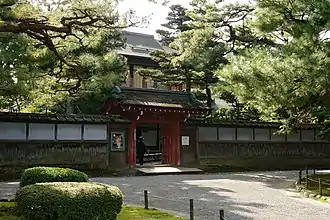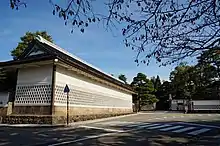Seisonkaku
The Seisonkaku (成巽閣) is a large Japanese villa in the city of Kanazawa, built in 1863 by Maeda Nariyasu (1811–1884), 13th daimyō of the Kaga clan,[1] as a retirement home for his mother Shinryu-in (眞龍院). A collection of her personal effects is open to the public.


It is one of the few buildings in Japan to display the possessions of a daimyo family in their original surroundings. The main floor is built in the buke-shoin (武家書院) style, with a formal guest chamber Ekken-no-ma (謁見の間), and a traditional covered walkway (engawa (縁側)) which opens onto a beautiful small garden. The walkway, named Horsetail corridor (つくしの廊下), is famous for being 20 meters long, with no supporting beams holding up the roof. The roof is supported with a cantilever that extends 10 meters back into the building, a Meiji-period architectural innovation.[1] The first floor showcases extensive architectural uses of artwork, from painted screens and doors to stained glass imported from the Netherlands.[1]
The second floor of the building is decorated in strong reds, blues and purples in the sukiya-shoin (数奇屋風書院) style. Some of the shōji screens on the second floor feature glass panes imported from the Netherlands, allowing snow viewing in wintertime without opening the screens.[1]
See also
References
- Seisonkaku tourist brochure, 2012